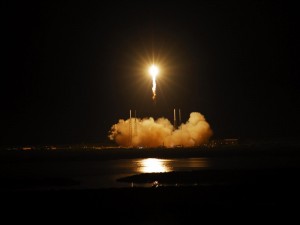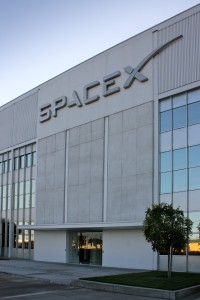Posts Tagged ‘SpaceX’
Falcon 9 v1.1 Test
Yesterday (September 29th), SpaceX launched the newest version of its Falcon 9 rocket, which includes an improved payload capacity of 13 tons to Low Earth Orbit. The new rocket also featured a preliminary version of the reusability package that SpaceX hopes will allow them to recover their rockets in a state suited to rapid turn-around, but there was no expectation that this rocket would return safely.
The primary payload this time was the Canadian Space Agency’s CASSIOPE satellite, which was launched into polar orbit. The CASSIOPE combined two distinct functions – the e-POP, which is supposed to gather information on solar storms, and Cascade, which is a technology demo for a digital broadband courier service. There were also five nano satellites on board.
Here’s the video from the launch. Unfortunately, there’s a lot of ‘Awaiting Vehicle Downlink’, and I wish they had just switched to a screen with telemetry data whenever the signal was lost. Still, the camera they had on the Falcon 9 provided a great view when the connection was active.
Elon Musk Explains SpaceX’s Cutting-Edge Design Tech
Elon Musk, founder of SpaceX, explains some of the back-end technology his company is working on that will revolutionize the way engineering is done. First he shows the technology used to manipulate 3-D designs intuitively with a hand in 3-D space instead of in a clunky way with 2-D interfaces (like a mouse). Anyone who’s tried to do 3-D design in the usual software using a mouse and all sorts of buttons will appreciate the potential that this new interface represents.
Unfortunately, he only shows manipulation of the design – there’s no indication that they can actually design parts from scratch using this interface. As a consolation, though, we do get to see them printing rocket parts with a 3-D printer (you know, a replicator).
Even though it’s not the great leap I was hoping for when Musk tweeted about it as a teaser, it’s still a step in the right direction from a company that’s producing a startling number of those steps, so I couldn’t resist sharing the video:
SpaceX’s Merlin 1D Test-Firing
The Merlin 1D engine will be used on the Falcon 9 and Falcon Heavy rockets to boost heavy loads into orbit. It’s at the very heart of SpaceX‘s most ambitious aspirations (so far), and I think the video of the test speaks for itself.
Congratulations to the SpaceX team. It looks like their hard work is really paying off, and I’m eager to see what they manage to do next.
SpaceX Falcon 9 Launch Successful
I’ll post more about it once the Dragon completes its mission and we find out whether it met all the mission requirements. For now, congratulations to the SpaceX team for the quick turnaround. Here’s a picture of this morning’s launch from NASA:
If the mission is successful, we will be in a new era of space flight. Some people are already declaring the start of the new era with the launch, but that’s a bit premature – it actually has to do some work up there. As you might already know from reading my other articles, I’m skeptical about private industry’s vision and ability to think big, but any space flight is better than none.
SpaceX Launch Delayed . . . Again
So, crossing your finger really doesn’t work, though I guess we should do some double-blind trials just to make sure.
The launch of SpaceX‘s Falcon 9/Dragon flight to the ISS went all the way to ignition early this morning, but engine five had abnormally high chamber pressure readings on lighting, requiring a computerized abort. SpaceX confirmed that this was not the result of a sensor malfunction nor any computer glitch. The fuel valve was apparently operating normally, so we’re still waiting to find out exactly what went wrong.
SpaceX noted that while a failure of two engines during flight would not cause a failure, all nine engines have to be operational for a successful liftoff. Pressure problems have occurred in testing and during the first demonstration flight as well, though in the first test the pressure was off by a narrower margin, suggesting a different fault.
SpaceX’s Rendevous with the ISS
Space X’s COTS (Commercial Orbital Transportation Services) Demo Flight 2 is scheduled for Saturday. If the demonstration completes all the objectives set forth by NASA, the Falcon-9/Dragon system will be certified for regular cargo deliveries to the International Space Station. In other words, the United States will finally have a private sector replacement for the Space Shuttle‘s cargo delivery function.
While we’re all hopeful for success in this new phase in space exploration, I wonder why we couldn’t have had a proven system in place earlier, before the retirement of the Shuttle. Why are we still dependent on Russia to get our personnel to and from the station? It feels like we’ve set ourselves back, as if it’s 1959 again and we’re once again behind the Russians. I hope we can close the gap again quickly.

